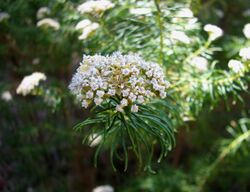Biology:Ozothamnus rogersianus
| Ozothamnus rogersianus | |
|---|---|

| |
| Scientific classification | |
| Kingdom: | Plantae |
| Clade: | Tracheophytes |
| Clade: | Angiosperms |
| Clade: | Eudicots |
| Clade: | Asterids |
| Order: | Asterales |
| Family: | Asteraceae |
| Genus: | Ozothamnus |
| Species: | O. rogersianus
|
| Binomial name | |
| Ozothamnus rogersianus (J.H.Willis) Anderb.[1]
| |
| Synonyms | |
|
Helichrysum rogersianus J.H.Willis | |
Ozothamnus rogersianus, commonly known as Nunniong everlasting, is a shrub in the family Asteraceae. It is endemic to Victoria, Australia.[2]
It grows to 2.5 metres high and has narrowly linear leaves that are 10 to 40 mm long and 1 to 2 mm wide. These have green upper surfaces, while underneath they are covered with fine white hairs and a sticky yellowish resin. The white flower heads appear from December to March in the species' native range.[2]
The species was formally described in 1967 by botanist Jim Willis in Muelleria.[3] Willis gave it the name Helichrysum rogersianum. The species epithet honours Keith Rogers of Wulgulmerang who discovered it at Brumby Point on the Nunniong Plateau in East Gippsland.[4] In 1991, the species was transferred to the genus Ozothamnus.[1][5]
References
- ↑ 1.0 1.1 "Ozothamnus rogersianus". Australian Plant Name Index (APNI), IBIS database. Centre for Plant Biodiversity Research, Australian Government, Canberra. http://www.anbg.gov.au/cgi-bin/apni?TAXON_NAME=Ozothamnus+rogersianus. Retrieved 3 March 2013.
- ↑ 2.0 2.1 Wild Plants of Victoria (database). Viridans Biological Databases & Department of Sustainability and Environment. 2009.
- ↑ , pp. 158, Wikidata Q104234711
- ↑ "Helichrysum rogersianum". Australian Plant Name Index (APNI), IBIS database. Centre for Plant Biodiversity Research, Australian Government, Canberra. http://www.anbg.gov.au/cgi-bin/apni?TAXON_NAME=Helichrysum+rogersianum. Retrieved 3 March 2013.
- ↑ Anderberg, A.A. (1991). "Taxonomy and Phylogeny of the Tribe Gnaphalieae (Asteraceae)". Opera Botanica 104: 89.
Wikidata ☰ Q7116670 entry
 |

